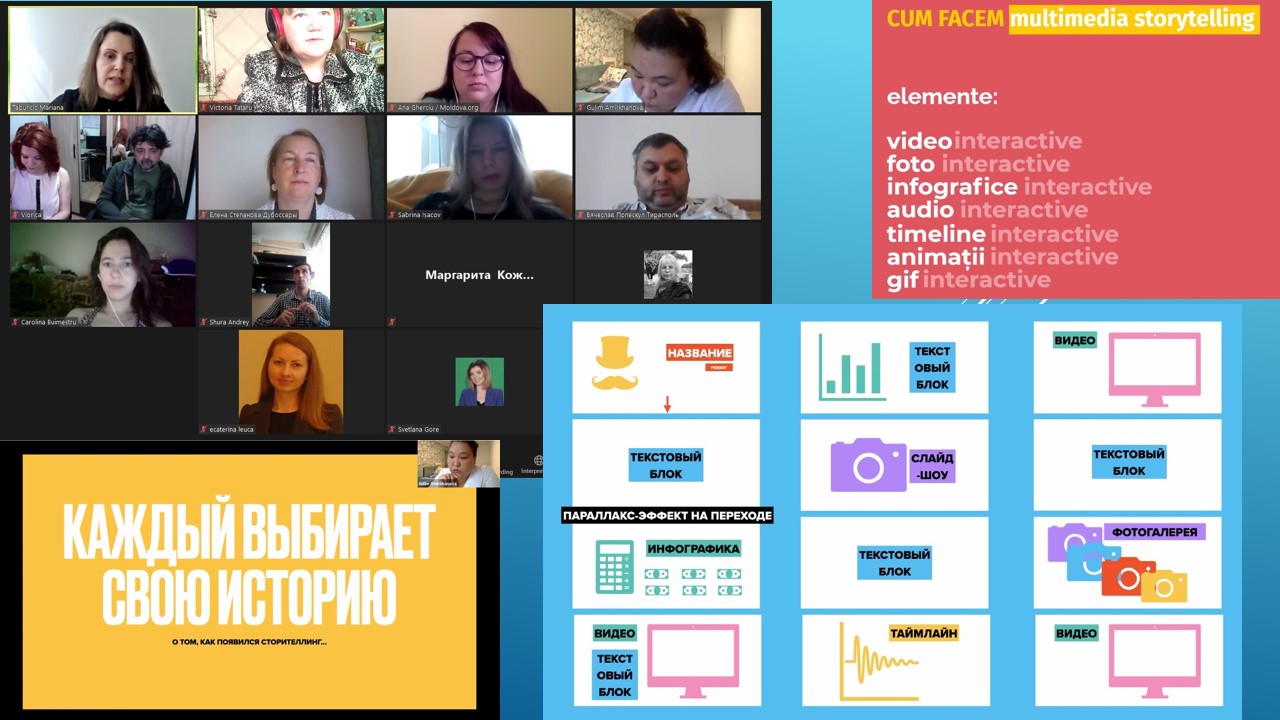
15 journalists from both banks of the Dniester have taken part in the training titled “Journalists from the Right and the Left Banks of the Dniester Create Multimedia Content.” The event was organized online by the Independent Journalism Center on June 9-11.
While opening the event, Mariana Tabuncic, IJC Program Manager, mentioned that one of the IJC’s goals was contributing to journalists’ professional development, improving their skills to help them keep up with current events and meet media consumers’ needs. “Journalism is a living system; it implies that media representatives need to consider innovations, including those in the sphere of digital storytelling, to create successful multimedia products on topics of public interest,” Mariana Tabuncic declared.
For three days, the participants were taught to develop multimedia content by the two coaches, journalists experienced in the sphere of new media. Gulim Amirkhanova, a TV journalist and author of TV and online journalism training programs from Kazakhstan, introduced the participants to the notion of digital storytelling, the evolution of the new press genre, and the features distinguishing multimedia content from traditional materials.
“Although the notion of storytelling was known long ago, this term did not exist as a separate format until 2006, when the Harvard Business Review mentioned storytelling as one of the most successful business ideas. It is also curious that the term did not emerge in the media sphere: initially, it was used in business, subsequently, in online advertising/marketing, and only afterwards, it shifted to journalism,” Gulim Amirkhanova explained the history of development of digital storytelling and multimedia products. “The fear of making a mistake is the reason why we still have so few multimedia products today,” she said, urging Moldovan journalists to overcome their fears and implement this sort of journalism as actively as possible.
The idea was also supported by the coach Ana Gherciu, journalist and editor-in-chief at Moldova.org. Passionate about storytelling and innovative methods of communicating with readers, she shared with the participants a number of behind-the-scenes secrets/details of discovering and applying interactive methods of generating multimedia content and using various online platforms to create this type of content. “I am glad that you have accepted an invitation to take part in this training course, which means that you are interested in multimedia products. At Moldova.org, we pay close attention to this interactive format, as it helps us write about Moldova’s problems in ordinary people’s words, and this is how we discover people and destinies which deserve to be known to our readers. I am sure that, after this training, you will love storytelling and multimedia, and be eager to practice them more and more,” Ana Gherciu said.
“Digital stories” which include interactive multimedia elements (texts, videos, audios, photos, infographics, etc.) presented by the two experts were interesting to the audience and made them pay more attention to this journalistic genre.
Carolina Buimestru, journalist, Creative Studio, Chisinau: “I am eager to create a multimedia project of my own. I have learned many new techniques, and now, I feel ready to try them.”
Luiza Dorosenco, “Centrul media” NGO Director, Malaiesti Village, Grigoriopol District: “I have taken part in the training because I have been intending to create multimedia content attractive to the public for a long while. I have many ideas; one of them is focused on the Romani life. However, teamwork will determine the subject to be chosen.”
Tatiana Sergheeva, “EtEcO” NGO website administrator, Tiraspol: “It is never too late to learn. I have been convinced of this fact once again while participating in this training focused on digital storytelling and multimedia content. It is a perfect challenge to try something new.”
Elena Stepanov, journalist, blogger, “Medicii pentru ecologie” Public Association, Dubasari “It is amazing to witness the extraordinary power of a multimedia product, which combines not only all types of journalism (newspaper, radio, and TV), but also various artistic elements from cinematography, painting, animation, etc. Many ideas have occurred to me during the training process. This time, I would like to create a common product together with my colleague Elena Motricala from Criuleni. We have learned a lot of new, useful, and interesting things. The examples presented by the coaches with international experience have inspired me to achieve new results in journalism.”
Elena Motricala, Editor-in-Chief, “Est-Curier” Periodical, Criuleni: “I have taken part in this training focused on new technologies with interest. From the very start, I realized that digital storytelling was a great challenge for those who are used to working in printed press.”
Irina Glusco, journalist, “MIR” Interstate TV Company, Chisinau: “I have decided to participate in the training because I would like to progress professionally; I am eager to find out new multimedia trends and learn from the experience of our foreign colleagues. Personally, I have learned a lot about the backstage issues of creating such a product. I am grateful to the coaches for the useful information they shared with us during the three working days. In the future, I would like to implement a multimedia project on a social and/or environmental/ecological issue which concerns citizens.”
After the training, 9 journalists from the media institutions from the right bank and 6 journalists from the media institutions from the left bank of the Dniester will create mixed teams of 2-3 persons and identify the topics they will work on together. The teams can suggest 1-2 multimedia product concepts targeting such spheres as upbringing/education, economy/business, ecology/environment, corruption, migration, minorities, healthcare, social protection, agriculture, and culture. The developed concepts will be sent to the IJC until June 20.
Three mixed teams which present the most original ideas and declared winners will be provided a financial support of 1500 Euros for preparing two multimedia materials to be published by media institutions on both banks of the Dniester.
The training is organized by the Independent Journalism Center with the financial support of the OSCE Mission to the Republic of Moldova within the project “Promoting Media Dialogue on Both Banks of the Dniester.”
















